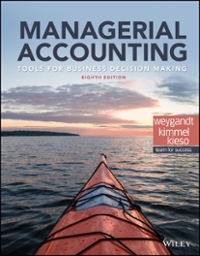Hints: 1. Start out by calculating Terry's COGS on TC178 given the original information. The best way to do this is to set up a formal COGS calculation like the one we did in the Income Statement in Terry #2. The formal calculation for one product would look just like the COGS section of the income statement, but it would only include the values for the one product. 2. Use the perpetual inventory method to find out what purchases, purchase discounts, and COGS should be for TC178 using a formal perpetual inventory table. Once you have those numbers, set up another formal COGS calculation like the one you made for the original information using the new information. 3. Compare the new COGS calculation to the old one. The differences between the two sets of calculations are the changes that you need to record in your journal entry. 4. When making your journal entry, keep in mind that Terry has a perpetual inventory system. This means the company doesn't have a "purchase returns" or a "purchase discount" account. Instead, everything will be done using the inventory account. Your final entry, then, should change only three accounts: COGS, Inventory, and A/P. You can get the changes to COGS and Inventory from the differences in your COGS equations (old vs. new). You will use A/P as the plug figure. Why? Well, to explain that, we have to go back to what the original journal entries look like for a company that uses the perpetual inventory system. When we buy inventory in a perpetual system, we debit inventory and credit A/P. When we pay for inventory, we debit A/P and credit cash. If we get a discount or make a return, we debit A/P and credit Inventory. That means that any mistake in recording purchases, returns, or discounts would cause a mistake in both the Inventory account AND the A/P account. Then when we sell inventory, we would debit COGS and credit Inventory, so mistake in recording sales would case a mistake in both Inventory AND COGS. So, in order to correct for all of Terry's mistakes, we need to adjust all three of those accounts: Inventory, COGS, and A/P.Perpetual LIFO Purchases Cost of Goods Sold Inventory Balance Date # of Units Prices Cost # of Units Price Cost # of Units Price Cost Beginning Balance 5400 S 43,200 5400 $ 8 S 43,200 Jan. 15 16000 $ 9 144,000 16000 $ 9 S 144,000 Feb.28 14000 $ 9 126,000 5400 $ 187,200 61,200 Mar. 14 9000 $ 11 99,000 2000 $ 91 160,200 Mar. 20 (2%%Disc. From Mar. 14) (1,980) 158,220 Mar. 30 9000 $ 10.78 97,020 61,200 1100 $ 9 S 9,900 5400 $ 8 51,300 Jul. 30 900 9 S 8,100 900 $ 9 2700 $ 21,600 o S 9 in in in in in in un 43,200 21,600 Aug. 20 15000 $ 14 $ 210,000 2700 $ 231,600 Sept. 2 7000 $ 14 $ 98,000 133,600 Dec. 1 6000 $ 84,000 49,600 2700 $ 8 2000 $ 14 45400 S 494,220 40700 S 444,620 4700 $ 49,600Cost of Goods Sold Accounts Amount Beg. Inventory 43,200 Add: Purchases 476,000 Less: Purchase Discounts (2,400) Less: Purchase Returns (3,800] Less: Ending Inventory (49,600) Total 463,400New Cost of Goods Sold Accounts Amounts Beg. Inventory 43,200 Add: Purchases 476,000 Less: Purcahses Discounts (4,380] Less: Purchase Returns (3,800) Less: Ending Inventory (49,600) COGS 461,420Infhmrnamhonn Terry's management is afraid that an error was made when calculating COGS. Most of the calculations have already been checked by the auditors, but management still thinks that one inventory item has not been correctly recorded. They would like you to go back through the inventory calculations for that item to correct any possible mistakes. Currently they show that 5,400 units of item T0178, purchased for $3 each, were on hand at the beginning of the year, that $476,000 worth of T0178 was purchased during the year, that discounts of $2,400 were earned by making early payments on these purchases, and that $3,800 worth of returns were made during the year. The records show that only 4,900 units of the beginning T0178 inventory remained at the end of the year. Terry uses the perpetual LIFO system for calculating inventory. Their inventory transactions for item TC1'78 for the period are as follows: (NOTE that the vendor provides free shipping on all units of T0178) - At the beginning of the period, 5,400 units of TC178, purchased for $8.00 each, were on hand. . On Jan 15, an additional 16,000 units were purchased for $9.00 each. . On February 28, 14,000 units were sold. - On March 14, an additional 9,000 units were purchased for $11.00 each. - On March 20, a 2.0% cash discount was earned by paying for the March 14 purchase early. . On March 30, 10,100 units were sold. . On July 30, 3,600 units were sold. . On August 20, an additional 15,000 units were purchased for $14.00 each. - On September 2, 7,000 units were sold. - On December 1, 6,000 units were sold. Terry's management would like to know the eect of the sale on the following ratios: . Inventory Turnover (COGS I average total inventory) - Current Ratio - ROA











